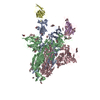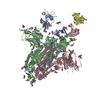+Search query
-Structure paper
| Title | Nanobodies Protecting From Lethal SARS-CoV-2 Infection Target Receptor Binding Epitopes Preserved in Virus Variants Other Than Omicron. |
|---|---|
| Journal, issue, pages | Front Immunol, Vol. 13, Page 863831, Year 2022 |
| Publish date | Apr 25, 2022 |
 Authors Authors | José M Casasnovas / Yago Margolles / María A Noriega / María Guzmán / Rocío Arranz / Roberto Melero / Mercedes Casanova / Juan Alberto Corbera / Nereida Jiménez-de-Oya / Pablo Gastaminza / Urtzi Garaigorta / Juan Carlos Saiz / Miguel Ángel Martín-Acebes / Luis Ángel Fernández /  |
| PubMed Abstract | The emergence of SARS-CoV-2 variants that escape from immune neutralization are challenging vaccines and antibodies developed to stop the COVID-19 pandemic. Thus, it is important to establish ...The emergence of SARS-CoV-2 variants that escape from immune neutralization are challenging vaccines and antibodies developed to stop the COVID-19 pandemic. Thus, it is important to establish therapeutics directed toward multiple or specific SARS-CoV-2 variants. The envelope spike (S) glycoprotein of SARS-CoV-2 is the key target of neutralizing antibodies (Abs). We selected a panel of nine nanobodies (Nbs) from dromedary camels immunized with the receptor-binding domain (RBD) of the S, and engineered Nb fusions as humanized heavy chain Abs (hcAbs). Nbs and derived hcAbs bound with subnanomolar or picomolar affinities to the S and its RBD, and S-binding cross-competition clustered them in two different groups. Most of the hcAbs hindered RBD binding to its human ACE2 (hACE2) receptor, blocked cell entry of viruses pseudotyped with the S protein and neutralized SARS-CoV-2 infection in cell cultures. Four potent neutralizing hcAbs prevented the progression to lethal SARS-CoV-2 infection in hACE2-transgenic mice, demonstrating their therapeutic potential. Cryo-electron microscopy identified Nb binding epitopes in and out the receptor binding motif (RBM), and showed different ways to prevent virus binding to its cell entry receptor. The Nb binding modes were consistent with its recognition of SARS-CoV-2 RBD variants; mono and bispecific hcAbs efficiently bound all variants of concern except omicron, which emphasized the immune escape capacity of this latest variant. |
 External links External links |  Front Immunol / Front Immunol /  PubMed:35547740 / PubMed:35547740 /  PubMed Central PubMed Central |
| Methods | EM (single particle) |
| Resolution | 3.2 - 3.9 Å |
| Structure data | EMDB-14313, PDB-7r4i: EMDB-14314, PDB-7r4q: EMDB-14315, PDB-7r4r: |
| Chemicals |  ChemComp-NAG: |
| Source |
|
 Keywords Keywords | VIRAL PROTEIN / coronavirus / COVID-19 / SARS-CoV-2 / spike / nanobodies / neutralization |
 Movie
Movie Controller
Controller Structure viewers
Structure viewers About Yorodumi Papers
About Yorodumi Papers











